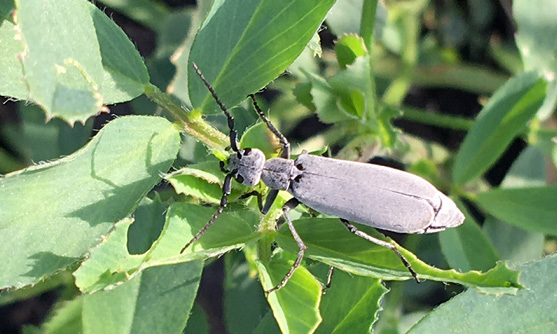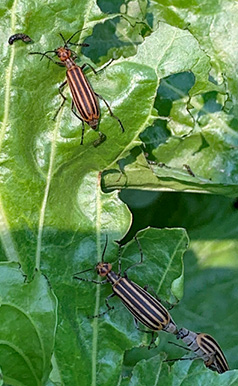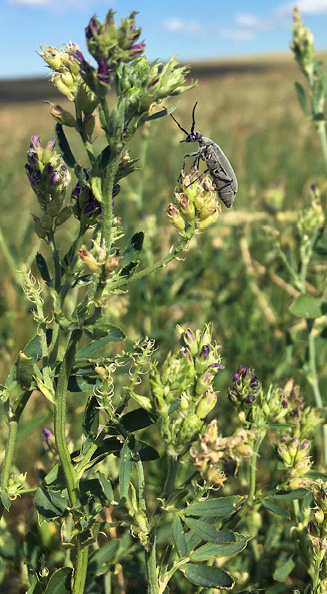Watch for Poisonous Blister Beetles When Cutting Hay
This page was adapted from the article, "Cutting Hay for Horses – Watch Out for Poisonous Blister Beetles!," which appeared in Crop & Pest Report on June 30, 2022.
Several blister beetle species feed on alfalfa, including: ash-gray blister beetle (Epicauta fabricii); black blister beetle (E. pensylvanica) and striped blister beetle (E. vittata). Adult blister beetles are easy to recognize due to their large size (½ to 1½ inch), soft bodies, short wing covers, long legs and a neck-like appearance between head and prothorax.


Most blister beetle species have one generation per year. Adults become active in early to mid-summer and females lay eggs in the soil. Eggs hatch in about two weeks into larvae called triungulins. Epicauta larva are beneficial insects and are effective predators of grasshopper eggs. Blister beetles overwinter in soil as larvae. Field reports indicate that blister beetles are high again in 2022 (like 2021) in most areas of hay production due to high grasshopper populations. Adult blister beetles are attracted to blooming alfalfa fields and weeds (goldenrods, dandelions). Adults are active June through September and will feed on nectar, pollen, leaves, stems and flowers.
The most severe threat from blister beetles is their poison called cantharidin, which is toxic to people and livestock, especially horses. Cantharidin oil is released when beetles are crushed and even dead beetles have high levels of the toxin that does not weaken. Cantharidin is highly toxic and irritates the gastrointestinal and urinary tracts, which can lead to death in horses. It is estimated that about 30 to 50 striped blister beetles could be potentially lethal to horses. Fewer beetles cause sores or blisters on tongue and mouth, colic, diarrhea, bloody feces, depression, elevated temperatures, increased heart rate, increased breathing rate and dehydration. Poisoned horses often place their muzzle in water without drinking.
Hay infested with blister beetles is a big concern for hay producers and livestock owners, especially horse owners. Cattle and sheep can also be poisoned. Levels of toxicity to beef cattle has not been identified. The amount of cantharidin produced by blister beetles varies by species (see Table), and male blister beetles produce higher amounts than female blister beetles. So, it is hard to predict how many blister beetles are needed to kill an animal. If you suspect cantharidin poisoning, contact your veterinarian immediately. Unfortunately, cantharidin poisoning has no cure except supportive care including mineral oil, intravenous fluid therapy, activated charcoal, and anesthetics.
|
Blister Beetle species |
275 lbs |
550 lbs |
825 lbs |
|---|---|---|---|
|
Black blister beetle |
550 |
1100 |
1700 |
|
Spotted blister beetle |
175 |
345 |
520 |
|
Three-striped blister beetle |
40 |
80 |
120 |
|
Source: Capinera et al. 1985. J. Econ. Entomol. 75: 1052-55. |
|||
Scouting: Blister beetles are difficult to scout for since they are mobile and gregarious, and often congregate in field edges or certain spots in a field with flowering weeds. In some instances, blister beetles feed for a short period of time and then migrate to other areas of the field or to new fields. After the alfalfa is cut, they often move out into blooming canola and other blooming field crops.

Integrated Pest Management:
Prior to harvest:
- Scout closely for blister beetles, swarms or defoliation immediately prior to harvest. If large populations of blister beetles are observed, producers should not harvest until beetles have moved out of field or an insecticide may be applied. There is no treatment threshold for blister beetles in alfalfa hay. If insecticides are used, read label directions for rates, pre-harvest intervals, restrictions and precautions. Fields should not be treated at peak bloom to avoid bee kill. Insecticides approved for blister beetle in alfalfa are listed in the 2022 North Dakota Field Crop Insect Management Guide E1143.
- Hay fields adjacent to rangeland pastures are at higher risk for blister beetle infestations due to typically higher grasshopper populations in rangeland pastures.
- Control blooming weed hosts near or in alfalfa fields.
- Cut alfalfa early at 10% bloom. Blooming alfalfa attracts blister beetles into the field.
At harvest:
- Fields should be rechecked 24 hours prior to cutting to ensure that new swarms of blister beetles have not re-infested the fields.
- Use equipment without hay conditioners or crimpers that may crush blister beetles, thus contaminating hay, or may increase the numbers of blister beetles located underneath the windrow. Even tractor tires can crush blister beetles in hay when turning equipment around. Cut hay with a sickle bar or rotary mower that allows blister beetles to move out of hay after cutting. If large numbers of blister beetles are observed in spots during harvesting, stop tractor and allow blister beetles to move out of the way or go around them.
- Raking may dislodge dead beetles from hay.
- Scout harvested hay and underneath windrows closely for blister beetles and allow blister beetles to move out of drying hay before baling. Turning the windrow may be helpful to get blister beetles to move out.
- If blister beetles are suspected in harvested hay, either don’t feed the hay or provide alternative feeds/hay for livestock. Don’t force livestock to eat hay contaminated with blister beetles.
- Chemical control is generally not recommended at harvest, because dead beetles could be incorporated into cured hay instead of falling onto the ground. Remember, dead blister beetles still have a level of cantharidin toxic to livestock.
- Grinding hay only dilutes the cantharidin toxin when the hay is mixed into a final ration.
- Cantharidin concentration for blister beetle toxin in equine or ruminants can now be measured by the NDSU Veterinary Diagnostic Lab: https://www.vdl.ndsu.edu/tests/blister-beetle-toxin-cantharidin/
For more information, consult the 2021 NDSU Extension publication on Blister Beetle Management in Forages and Field Crops E1002 (revised).